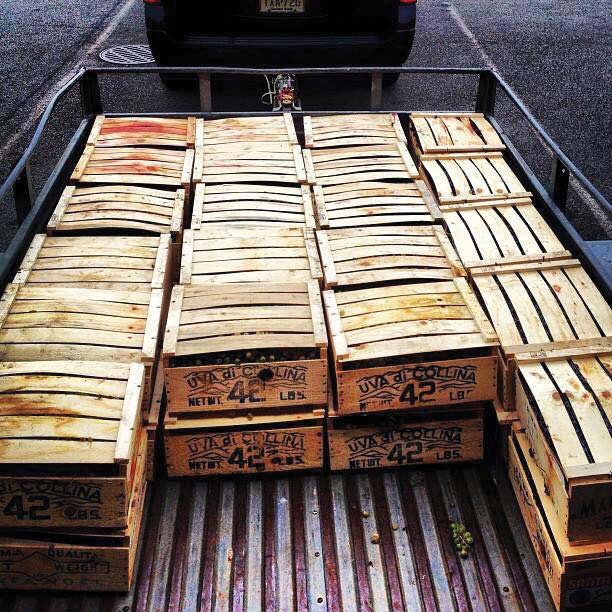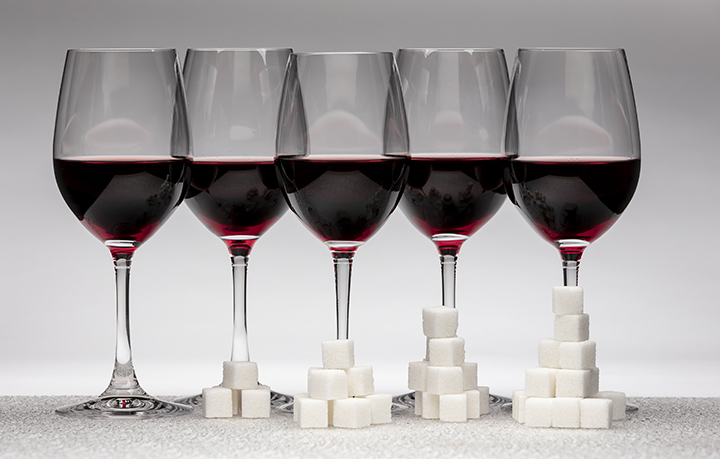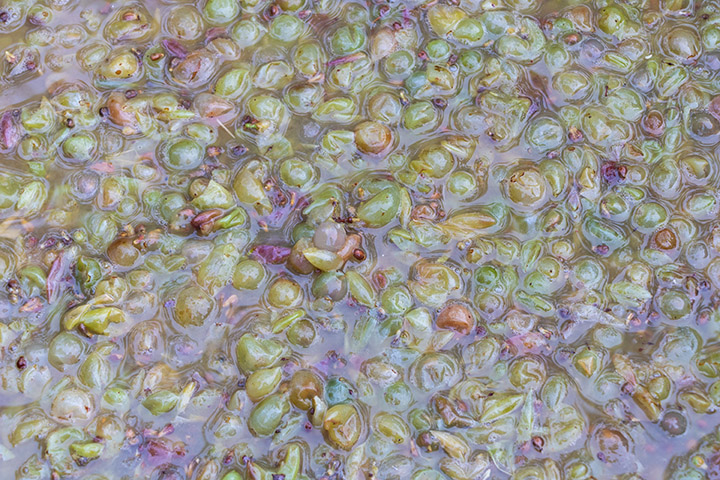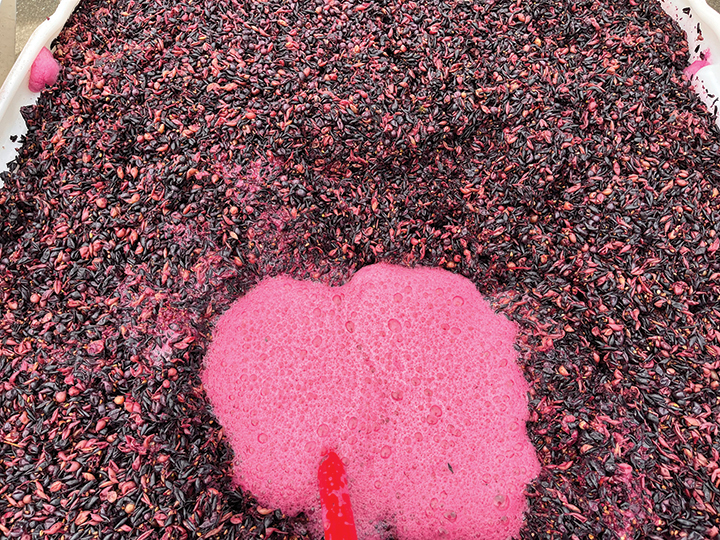Pick of the Litter
Finding the best grapes
What are the best grapes for winemaking? The first decision is usually the grape variety or, at least, wine style you are interested in. Once you locate a source for the kind of grapes you want, the next considerations are quality and transportation. Key quality parameters are those that reflect ripeness of the crop, usually sugar (as degrees Brix) and acid (as both pH and titratable acidity — TA). Transportation may become a factor because the quality of harvested grapes begins to deteriorate as soon as they are picked. Some grapes will inevitably break, releasing juice. Fruit flies can become a problem and they tend to spread Acetobacter microorganisms that can begin producing volatile acidity —vinegar. While sulfite and chilling can both help preserve grape quality, try to keep your transportation time as short as possible once your style and quality goals are met.

Fresh wine grapes are available for hobbyists through a variety of channels. Finding a trusted source is key to making great wines. Photo courtesy of the Blue Bulls Wine Company
A fine place to start your search for the best grapes is at your local home winemaking supply store. The owners and associates there are almost certainly home winemakers themselves and they have ties to many others in your community. In addition to informal knowledge of who grows grapes near you, the store may maintain a list or database of sources. The store I retired from six years ago in Santa Rosa, California, has transitioned from paper records to online digital information. While I was there, we had a three-ring binder in the store that we filled with listings by local growers who were willing to sell in quantities useful to home winemakers — that is, in the hundreds of pounds instead of tons. Similar listings are now maintained by the store at a special online database. Typical information asked of growers includes grape variety, quantity available and any minimum purchase amount, price per pound (kilo), and estimated harvest date.
Additional data may include who is going to pick the grapes. Some growers prefer to have their own crew do the picking, some want you to help, and some leave it entirely to you to pick
your own grapes. When I first made Sauvignon Blanc for a style comparison at the 2020 WineMaker Magazine conference (that was later postponed), I used this method to find the grapes. Ed Johnson of Mendocino County had originally listed his Grenache, Grenache Blanc, and Sauvignon Blanc in the store binder. I had purchased successfully from him before, so I contacted him a couple of months ahead of the 2019 harvest. About a week before his harvest date, Ed called me to let me know to be at his vineyard at 8:00 a.m. on the day he had in mind. My wife, Marty, and I drove out to Potter Valley as planned, taking along four 32-gallon (121-L) square bins and one 20-gallon (76-L) round bin that I knew could hold the 600 lbs. (272 kg) that I wanted. Ed has a regular crew of vineyard workers who do his harvesting for him. In less than an hour they picked the grapes directly into my bins, Marty wrote Ed a check, and we were on our way home with cool, early-morning grapes.
Another excellent resource for grapes is a local home winemaking club. Join the club and find out where everyone else sources grapes. The club may also provide more formal identification of sources. Near me, one such club is GENCO, or the Garage Enologists of North County. Meeting in Healdsburg, California, they are noteworthy for organizing group harvests and subsequent winemaking, particularly for new members. One such group project is hosted by a member with a vineyard where everyone picks and crushes the project grapes. Another nearby club, Sonoma Home Winemakers, announces available grapes in a regular segment of monthly summertime meetings. A unique project by that club is the maintenance and harvest of a city-owned, one-acre (0.4 ha) vineyard.
Friends who make wine can help you find grapes, too. They are sourcing their fruit somewhere and most like to share insider information as much as they like to share their wine. A workplace-based group of likeminded employees can get more people involved and share the work. Ask if you can join if there is a group near you, or start one yourself if not. One of the benefits of such a group is that you can buy in commercial quantities. A group of employees at my store contracted with a nearby commercial vineyard to drop off a half-ton (half-tonne) bin of freshly picked Pinot Gris grapes. We all took turns pitch-forking the grapes into our own smaller bins, then took them home to crush and press. Newer employees joined groups at the homes of others who already had winemaking equipment. That way, they could go home with PET carboys full of freshly pressed juice and then finish the wine on their own.
A fine place to start your search for the best grapes is at your local home winemaking supply store.
While they may seem old-fashioned, classified ads are still out there. There may be printed versions for the wine industry in prime growing areas, but many have moved online. One of those is WineIndustry.com Classifieds. They list a wide variety of categories for equipment and supplies for vineyards and wineries, but important to this discussion is listings of grapes. You can search by geographic area all across the United States, plus growing regions in Canada and Mexico. Many of the listings are for purchasing grapes in commercial winery quantities, but you may be able to negotiate smaller amounts — or put together a buyer’s group as described above. Each listing in the classified ads includes the variety of grapes for sale, the potential quantity, the growing region, and the price.
Do you have a favorite local winery? They need to get their grapes somewhere, too. It’s worth asking. If they grow their own, they may be willing to sell you a small portion. If they purchase grapes from other growers, they may be willing to let you piggy-back on their order and come pick up your grapes at the winery on harvest day. For white wine, they may even do the pressing and allow you to purchase and pick up fresh juice. That is how my final Sauvignon Blanc style comparison became a reality at the 2022 conference.
The 2019 Potter Valley wine was delicious, but by the time pandemic restrictions eased enough to allow the conference to proceed for 2022 the style nuances had become subdued. As a replacement, I contacted WineMaker columnist Chik Brenneman who is a partner and the winemaker at West Sacramento’s Baker Family Wines. He was planning to make a 2021 Sauvignon Blanc and offered to take the grapes to his winery and include a portion for my project. He crushed, pressed, chilled, and sulfited the juice on harvest day. I drove to West Sacramento the next day, brought home the juice in PET carboys, and started the fermentations that some of you had the chance to taste in San Luis Obispo last year.
Most of the methods described so far work best if you are in or near a commercial winegrowing region. If not, a very good source is a distributor of grapes for home winemakers. Companies like Musto Wine Grape in Connecticut have long-term contracts with well-established growers and may grow grapes themselves. Many grape distributors can give you a bottle of finished wine made from the grapes that they source so you can taste the quality of the grapes you are interested in.
Some companies (like Musto) can run a panel on your grapes to give you the Brix, TA, and pH in case you don’t have the equipment. Their websites show timing, sourcing, pricing, and shipping of wine grapes in 36-lb. (16-kg) lug boxes. Major cities across the U.S. and Canada have distributors of this kind, so check in your area. Some of them also bring in fresh grapes from the Southern Hemisphere in the springtime of the Northern Hemisphere. I used some of those — Chilean Carménère — for a “Making Wine from Grapes” Boot Camp at another WineMaker Conference. Quality was high and the red and rosé wines that my students made turned out well.
Outside of wine industry sources, there may be other ways for you to get your grapes. Several sources show up if you are willing to make wine from seedless table grapes instead of wine grapes. Many of the table grapes are actually vinifera varieties and can be made into good, drinkable wine. Since wine grapes are sometimes difficult to source in late spring, but table grapes are available year-round, I most often use Black Seedless table grapes for my WineMaker Conference Boot Camps. Sometimes they are from Mexico and sometimes from Bakersfield in California’s Central Valley.
Getting those grapes almost every year has introduced me to the alternate sources. In San Diego, I was referred to a produce distributor with a warehouse where restaurants and small stores can come and buy wholesale produce. After I called ahead, they had my grapes chilled and ready for me. In San Luis Obispo, another local produce distributor brought the grapes to the conference hotel for me. Also, every supermarket has a produce manager who orders weekly. With a couple of weeks’ notice, that manager can get you as many 18-lb. (8-kg) lugs of table grapes as you can handle.
Farm stands also bring in wholesale produce and will often make a special purchase for you if you order ahead. Thinking further outside the box, do you have friends who live in wine country? If they are also home winemakers, they may be growing their own and may share. If not growing, they at least know some sources. Even if they don’t make wine, they can ask the questions of their local suppliers as described earlier for sourcing wine country grapes. They may be able to accept delivery for you at their home — all you need to do is plan your road trip to go out and collect them.
If your source is remote, you will mostly rely on the reputation of the supplier to assure quality. If the source is local, try to visit the vineyard during the growing season and observe maintenance and care of the vines. If a grower will let you help pick, it is well worth your time (even though it is hard work). There is nothing like being right in among the vines on harvest day to get a good feel for the crop quality. When you pick up grapes locally, try to do it early in the morning and keep the grapes as cool as you can. Consider putting dry ice (not inside a closed car!) on top of the grapes or spread around a few frozen gel packs. Once home, sort out and discard any rotten or moldy fruit. As you begin to crush, collect some juice and test for Brix, pH, and acidity. Make any needed adjustments as early in the process as you can. Once fermentation starts, begin your search for next year’s grapes!





